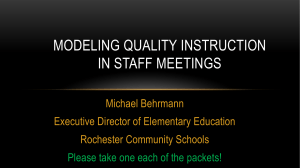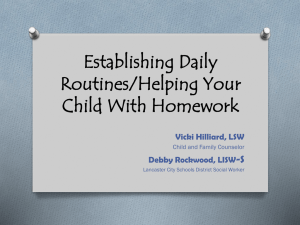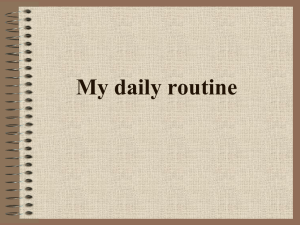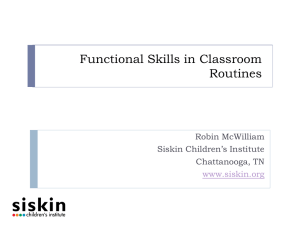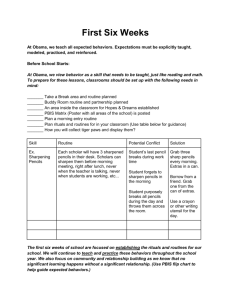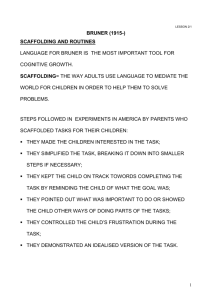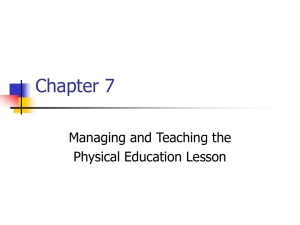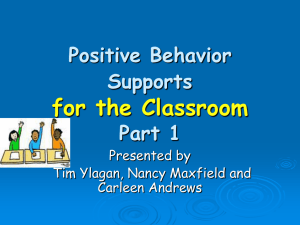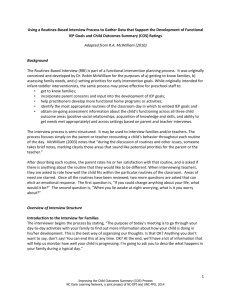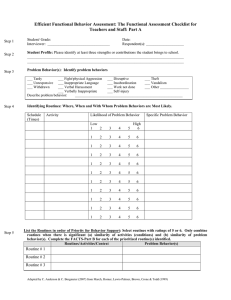Shane Teacher Facts
advertisement
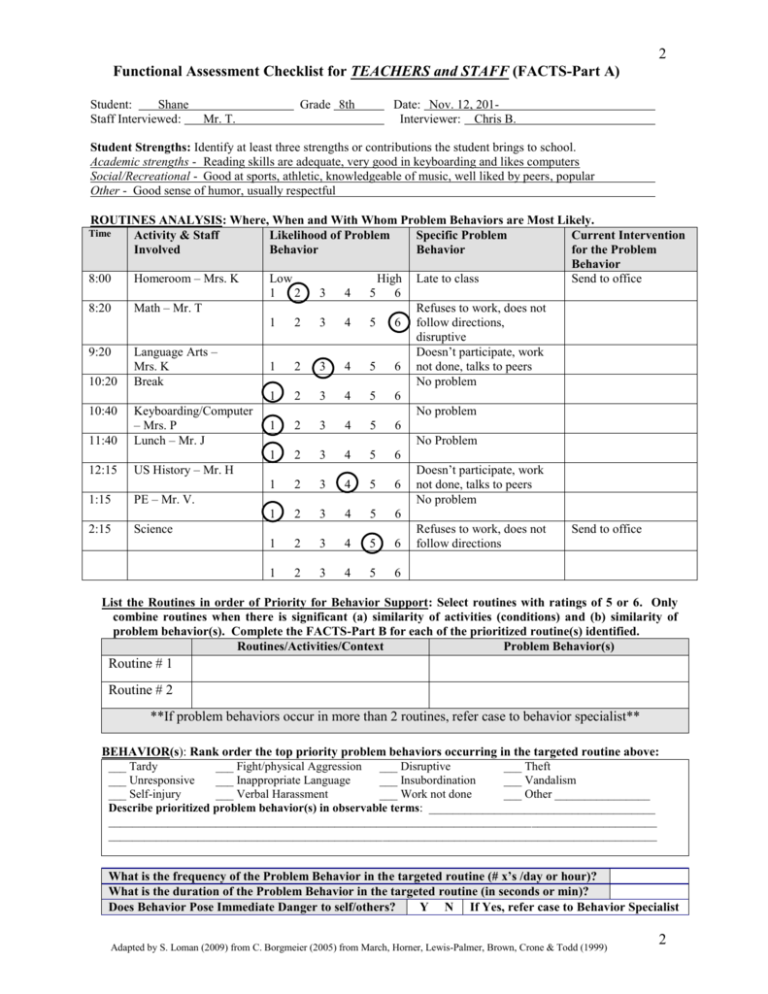
2 Functional Assessment Checklist for TEACHERS and STAFF (FACTS-Part A) Student: Shane Staff Interviewed: Grade 8th Date: Nov. 12, 201Interviewer: Chris B. Mr. T. Student Strengths: Identify at least three strengths or contributions the student brings to school. Academic strengths - Reading skills are adequate, very good in keyboarding and likes computers Social/Recreational - Good at sports, athletic, knowledgeable of music, well liked by peers, popular Other - Good sense of humor, usually respectful ROUTINES ANALYSIS: Where, When and With Whom Problem Behaviors are Most Likely. Activity & Staff Likelihood of Problem Specific Problem Current Intervention Involved Behavior Behavior for the Problem Behavior 8:00 Homeroom – Mrs. K Low High Late to class Send to office 1 2 3 4 5 6 8:20 Math – Mr. T Refuses to work, does not 1 2 3 4 5 6 follow directions, disruptive 9:20 Language Arts – Doesn’t participate, work Mrs. K 1 2 3 4 5 6 not done, talks to peers 10:20 Break No problem 1 2 3 4 5 6 10:40 Keyboarding/Computer No problem – Mrs. P 1 2 3 4 5 6 11:40 Lunch – Mr. J No Problem 1 2 3 4 5 6 12:15 US History – Mr. H Doesn’t participate, work 1 2 3 4 5 6 not done, talks to peers 1:15 PE – Mr. V. No problem 1 2 3 4 5 6 2:15 Science Refuses to work, does not Send to office 1 2 3 4 5 6 follow directions Time 1 2 3 4 5 6 List the Routines in order of Priority for Behavior Support: Select routines with ratings of 5 or 6. Only combine routines when there is significant (a) similarity of activities (conditions) and (b) similarity of problem behavior(s). Complete the FACTS-Part B for each of the prioritized routine(s) identified. Routines/Activities/Context Problem Behavior(s) Routine # 1 Routine # 2 **If problem behaviors occur in more than 2 routines, refer case to behavior specialist** BEHAVIOR(s): Rank order the top priority problem behaviors occurring in the targeted routine above: ___ Tardy ___ Fight/physical Aggression ___ Disruptive ___ Theft ___ Unresponsive ___ Inappropriate Language ___ Insubordination ___ Vandalism ___ Self-injury ___ Verbal Harassment ___ Work not done ___ Other ________________ Describe prioritized problem behavior(s) in observable terms: ______________________________________ ____________________________________________________________________________________________ ____________________________________________________________________________________________ What is the frequency of the Problem Behavior in the targeted routine (# x’s /day or hour)? What is the duration of the Problem Behavior in the targeted routine (in seconds or min)? Does Behavior Pose Immediate Danger to self/others? Y N If Yes, refer case to Behavior Specialist Adapted by S. Loman (2009) from C. Borgmeier (2005) from March, Horner, Lewis-Palmer, Brown, Crone & Todd (1999) 2 3 Functional Assessment Checklist for TEACHERS & STAFF (FACTS-Part B) Identify the Target Routine: Select ONE of the prioritized routines from FACTS-Part A for assessment. Routine/Activities/Context Problem Behavior(s) – make description observable ANTECEDENT(s): Rank Order the strongest triggers/predictors of problem behavior in the routine above. Then ask corresponding follow-up question(s) to get a detailed understanding of triggers ranked #1 & 2. Environmental Features (Rank order strongest 3) Follow Up Questions – Get as Specific as possible ___ a. task too hard ___ g. large group instruction If a,b,c,d or e - describe task/demand in detail ___________ ___ b. task too easy ___ h. small group work _________________________________________________ ___ c. bored w/ task ___ i. independent work If f - describe purpose of correction, voice tone, volume etc. ___ d. task too long ___ j. unstructured time _________________________________________________ ___ e. physical demand ___ k. transitions If g, h, I, j or k - describe setting/activity/content in detail ___ f. correction/reprimand ___ l. with peers _________________________________________________ ___ Other _____________ ___m. isolated/ no attn If l – what peers? __________________________________ describe___________________________________ If m – describe CONSEQUENCE(s): Rank Order the strongest pay-off for student that appears most likely to maintain the problem behavior in the routine above. The ask follow-up questions to detail consequences ranked #1 & 2. Consequences/Function As applicable -- Follow Up Questions – Get as Specific as possible ___ a. get adult attention If a or b -- Whose attention is obtained?_____________________________ ___ b. get peer attention ______________________________________________________________ ___ c. get preferred activity How is the attention provided? _____________________________________ ___ d. get object/things/money ___ e. get other, describe _________ If c or d -- What specific item or activity is obtained? __________________ __________________________ ______________________________________________________________ __________________________ ___ f. avoid hard tasks/failure If f, g or h – Describe specific task/ activity avoided? __________________ ___ g. avoid undesired task/activity ______________________________________________________________ ___ h. avoid physical effort Be specific, DO NOT simply list subject area, but specifically describe type of work within the subject area (be precise)?___________________________ ___ i. avoid peer negatives ______________________________________________________________ ___ j. avoid adult attention __________________Can the student perform the task independently? Y N ___ k. avoid reprimands Is academic assessment needed to ID specific skill deficits? Y N ___ l. avoid/escape other, describe If i, j or k -- Who is avoided? _____________________________________ ________________________ Why avoiding this person? SETTING EVENT(s): Rank Order any events that happen outside of the immediate routine (at home or earlier in day) that commonly make problem behavior more likely or worse in the routine above. __ hunger __ conflict at home __ conflict at school __ missed medication __ illness __failure in previous class __ lack of sleep __change in routine __ homework not done __ not sure __ Other___________________________ SUMMARY OF BEHAVIOR Fill in boxes below using top ranked responses and follow-up responses from corresponding categories above. ANTECEDENT(s) / Triggers Problem Behavior(s) CONSEQUENCE(s)/ Function SETTING EVENTS How likely is it that this Summary of Behavior accurately explains the identified behavior occurring? Not real sure 100% Sure/No Doubt 1 2 3 4 5 6 Adapted by S. Loman (2009) from C. Borgmeier (2005) from March, Horner, Lewis-Palmer, Brown, Crone & Todd (1999) 3
